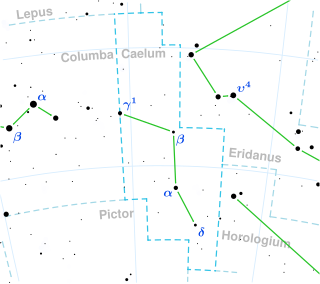
RV Caeli, also known as HD 28552, is a solitary, red hued variable star located in the southern constellation Caelum, the chisel. It has an apparent magnitude of 6.4, placing it near the limit for naked eye visibility. The object is located relatively far at a distance of 1,340 light years based on parallax measurements from Gaia DR3, but is rapidly receding with a heliocentric radial velocity of 98 km/s.

NO Apodis is a solitary, red hued variable star located in the southern circumpolar constellation Apus. It has an average apparent magnitude of 5.86, allowing it to be faintly seen with the naked eye. The object is relatively far at a distance of 790 light years but is drifting closer with a heliocentric radial velocity −18.3 km/s.
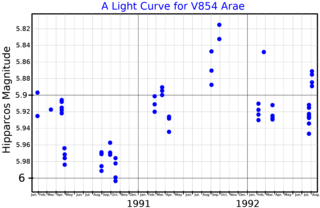
HD 155035 is the Henry Draper Catalogue designation for a star in the constellation Ara, the Altar. It is located at a distance of approximately 1,450 light-years from Earth and has an apparent visual magnitude of 5.92, making it is faintly visible to the naked eye. This is a red giant star with a stellar classification of M1.5 III. It an irregular variable that changes brightness over an amplitude range of 0.12 magnitudes.
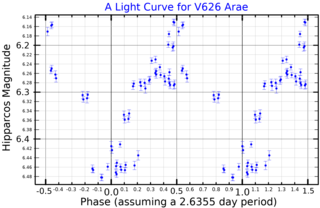
HD 160342 is a star in the southern constellation of Ara. HD 160342 is its Henry Draper Catalogue designation. It has an apparent visual magnitude of 6.35 and, based upon parallax measurements, is approximately 960 light-years distant from Earth.

HD 33463 is a suspected variable star in the northern constellation of Auriga, about 1,050 light years away. It is a red giant star with a stellar classification of M2III, and has expanded away from the main sequence after exhausting its core hydrogen. It has reached 133 times the size of the Sun and, at an effective temperature of 3,753 K it shines at a bolometric luminosity of 2,114 L☉.

HD 27245, also known as HR 1335 or rarely 25 H. Camelopardalis is a solitary red-hued star located in the northern circumpolar constellation Camelopardalis. It has an apparent magnitude of 5.4, making it faintly visible to the naked eye. Gaia DR3 Parallax measurements place it approximately 607 light years away from it the Solar System and is drifting further away with a heliocentric radial velocity of 25.2 km/s. At its current distance, HD 27245's brightness is diminished by 0.36 magnitudes due to extinction from interstellar dust. It has an absolute magnitude of −0.27.

V4381 Sagittarii is a variable star in the constellation Sagittarius. A white supergiant of spectral type A2/A3Iab, it is an Alpha Cygni variable that varies between apparent photographic magnitudes 6.57 and 6.62. Its visual apparent magnitude is about 6.54.
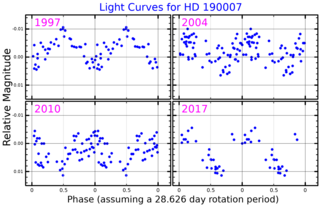
HD 190007, also known as Gliese 775, is a star in the constellation of Aquila. Parallax measurements by Gaia put the star at a distance of 41.5 light-years away.
HD 91496 is a giant star in the constellation Carina, with an apparent magnitude is 4.92 and an MK spectral class of K4/5 III. It has been suspected of varying in brightness, but this has not been confirmed.

Sigma Ophiuchi, Latinized from σ Ophiuchi, is a single, orange-hued star in the equatorial constellation Ophiuchus. Its apparent visual magnitude is 4.31, which is bright enough to be faintly visible to the naked eye. The annual parallax shift of 3.62 mas as seen from Earth provides a distance estimate of roughly 900 light years. It is moving closer to the Sun with a radial velocity of −28 km/s.

MZ Puppis is a red supergiant star in the constellation of Puppis. It has a radius of 400 R☉.

Iota Mensae is a single star about 880 light years away in the faint constellation Mensa. It has a very slightly variable apparent magnitude of 6.0, making it visible with the naked eye under good skies.
HD 76270, also known as HR 3544, is a solitary, white hued star located in the southern circumpolar constellation Volans. It has an apparent magnitude of 6.10, making it faintly visible to the naked eye if viewed under ideal conditions. The object is relatively far with a distance of 2,360 light years, but is slowly approaching the Solar System with a heliocentric radial velocity of −2.6 km/s.

HD 150193 is a binary star system in the constellation of Ophiuchus. The primary star was identified as a Herbig Ae/Be star with a strong solar wind, losing approximately a tenth of solar mass per million years. It does host a very small debris disk, likely due to disk truncation by the nearby stellar companion. The disk is inclined 38±9° to the plane of sky. It appears to be highly evolved and asymmetric, with indications of flattening and grains growth.
HD 200044 is a solitary star in the equatorial constellation Delphinus. It has an apparent magnitude of 5.7, allowing it to be faintly seen with the naked eye. The object is located 598 light years away, but is approaching the Solar System with a heliocentric radial velocity of −15.07 km/s.

HD 174387 is a solitary star in the southern constellation Telescopium. With an apparent magnitude of 5.49, it is faintly visible to the naked eye if viewed under dark skies. Parallax measurements put the object at a distance of 810 light years and it is currently approaching the Solar System with a heliocentric radial velocity of −28.1 km/s.
HD 1032 is a solitary star in the southern circumpolar constellation Octans. It is faintly visible to the naked eye with an apparent magnitude of 5.77 and is estimated to be 850 light years away from the Solar System based on parallax measure. However, it is receding with a heliocentric radial velocity of 4 km/s.

8 Leonis Minoris is a solitary, red hued star located in the northern constellation Leo Minor. It has an apparent magnitude 5.37, making it faintly visible to the naked eye. Based on parallax measurements from the Gaia satellite, the object is estimated to be 492 light years distant. It is receding with a heliocentric radial velocity of 40 km/s. At its current distance, 8 LMi is diminshed by 0.12 magnitudes due to interstellar dust.
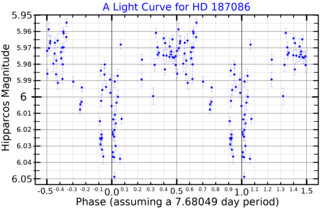
HD 187086, also known as HR 7537, is a probable astrometric binary located in the southern constellation Telescopium. It has an average apparent magnitude of 5.9, making it faintly visible to the naked eye. The star is located relatively far at a distance of 1,020 light years based on Gaia DR3 parallax measurements but is rapidly drifting closer with a heliocentric radial velocity of −64 km/s. At its current distance, HD 187086's brightness is diminished by 0.27 magnitudes due to interstellar dust. It has an absolute magnitude of −0.8.

HD 192827, also known as HR 7745 or rarely 83 G. Telescopii, is a solitary red hued star located in the southern constellation Telescopium. It has an apparent magnitude of 6.28, placing it near the limit for naked eye visibility. The object is located relatively far at a distance of 1,320 light years based on Gaia DR3 parallax measurements, but it is approaching with a heliocentric radial velocity of −43.7 km/s. At its current distance, HD 192827's brightness is diminished by 0.19 magnitudes due to interstellar dust and it has an absolute magnitude of −1.07.















